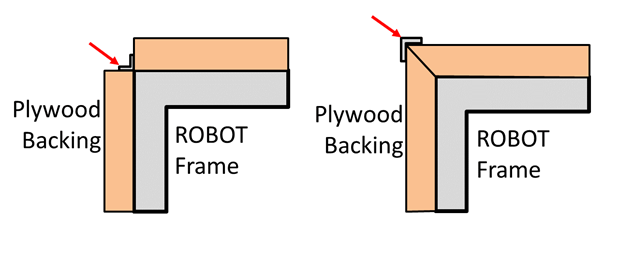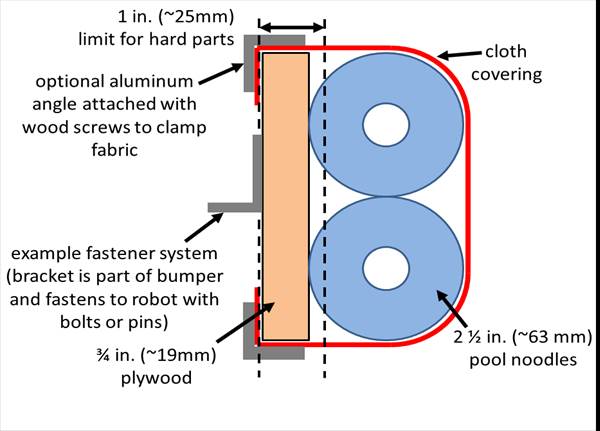R408
*BUMPER construction. BUMPERS
must be constructed as follows, such that the cross section resembles Figure 8‑6:
A.
be backed by ¾ in. thick (nominal, ~19mm) by 5 in. ± ½ in. (~127 mm ±
12.7 mm) tall plywood, Oriented Strand Board (OSB) or solid wood (with the
exception of balsa). Small clearance pockets to accommodate minor protrusions
permitted per R101 and/or holes needed to access or recess
mounting hardware in the wood backing are permitted, as long as they do not
significantly affect the structural integrity of the BUMPER.
¾ in. plywood and OSB refer to items sold by VENDORS as
that material and thickness, teams may not fabricate their own plywood or OSB.
Other engineered woods such as Fiberboard or Particle Board are not likely to
survive the rigors of FIRST Robotics Competition gameplay and thus not
permitted per A.
Note: ¾ in. plywood is often marked according to the actual
dimension (²³⁄₃₂) not the nominal size. Plywood sold as ²³⁄₃₂ meets the requirements of A.
B.
hard BUMPER parts allowed per A, E, F, and G must not extend more than 1
in. (~25 mm) beyond the FRAME PERIMETER (measured as shown in Figure 8‑4).
Figure 8‑4 Hard parts of BUMPER
corners

C.
use a stacked pair of 2½ in. (~63 mm) round, petal, or hex pool
noodles (solid or hollow) as the BUMPER cushion material (see Figure 8‑6). All pool noodles used in a BUMPER set (e.g. red set of BUMPERS)
may not be modified (with the exception of cutting to length or cutting to
facilitate mating pool noodles at the corners as required by R409)
or deformed and must be the same diameter, cross section, and density (e.g. all
round hollow or all hex solid). Pool noodles may be attached together using
soft fasteners like tape, provided the physical properties of the BUMPER are
not significantly altered. Per R409 cushion material may
extend beyond the end of the plywood in order to fill a corner (see Figure 8‑7). To assist in applying the fabric covering, soft fasteners may be
used to attach the pool noodles to the wood backing, so long as the cross
section in Figure 8‑6 is not significantly altered (e.g. tape compressing
the pool noodles).
2½ in. (~63 mm) pool noodles are pool noodles either sold
as 2½ in. (~63 mm) diameter or that measure between 2⅛ in. (~54 mm) pool
noodles and 2¾ in. (~70 mm) diameter.
All pool noodles used on a ROBOT must be the same in order
to maintain the desired interaction between ROBOTS in the cases of BUMPER-to-BUMPER
contact. BUMPERS containing pool noodles of vastly different construction may
cause a ramp effect when interacting with other BUMPERS.
Minor noodle compression as a result of smoothing BUMPER
fabric or rounding a FRAME PERIMETER corner is not considered deformed. Any
compression beyond that, e.g. for the purposes of flattening the pool noodle,
is deformation and a violation of C.
D.
be covered with a rugged, smooth cloth with no additional coating
applied by the team except for BUMPER markings permitted per R405
(multiple layers of cloth and seams are permitted if needed to accommodate R405 and/or R406, provided the cross
section in Figure 8‑6 is not significantly altered).
Silk and bedding are not considered rugged cloths, however
1000D Cordura is. Tape (e.g. gaffers tape) matching the BUMPER color is
allowed to patch small holes on a temporary basis.
It is expected that there may be multiple layers of cloth
as fabric is folded to accommodate the corners and seams of BUMPERS.
Non-woven materials such as leather or pleather are not
considered cloth.
The cloth must
completely enclose all exterior surfaces of the wood and pool noodle material
when the BUMPER is installed on the ROBOT. The fabric covering the BUMPERS must
be solid in color.
E.
optionally use metal angle, as shown in Figure 8‑6 or other
fasteners (e.g. staples, screws, adhesives, etc.) to clamp cloth.
F.
optionally use metal brackets (i.e. angle or sheet metal) or other
fasteners (e.g. staples, screws, adhesives, etc.) to attach BUMPER segments to
each other (see Figure 8‑5).
Figure 8‑5 Example uses of brackets in
BUMPER corners

G.
must attach to the FRAME PERIMETER of the ROBOT with a rigid fastening
system to form a tight, robust connection to the main structure/frame (e.g. not
attached with hook-and-loop tape, tape, or cable ties). The attachment system
must be designed to withstand vigorous game play. All removable fasteners (e.g.
bolts, locking pins, pip-pins, etc.) will be considered part of the BUMPERS.
Figure 8‑6 BUMPER vertical cross
section




 Buy me a hot chocolate
Buy me a hot chocolate